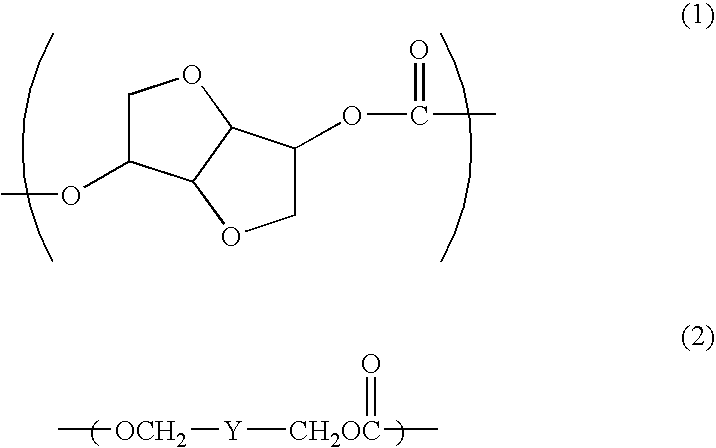Polycarbonate resin and optical film using the same
- Summary
- Abstract
- Description
- Claims
- Application Information
AI Technical Summary
Benefits of technology
Problems solved by technology
Method used
Image
Examples
example 1
[0056]5.846 kg (40 mols) of isosorbide (ISB) (dihydroxy compound represented by the formula (4)), 0.079 kg (0.4 mols) of tricyclodecanedimethanol (TCDDM) (dihydroxy compound represented by the general formula (5)), 8.869 kg (41.40 mols) of diphenyl carbonate (DPC) (carbonic acid diester), and 0.00123 g (1.46×10−5 mols) of sodium hydrogen carbonate were put into a 50-liter reactor including a stirrer and a distillation apparatus. These substances were heated up to 215° C. over 1 hour in a nitrogen atmosphere of 760 Torr while being stirred. Then, the pressure was adjusted to be reduced to 150 Ton over 30 minutes, and transesterification reaction was performed for 40 minutes under the conditions of 215° C. and 150 Torr. Then, the temperature was raised to 240° C. at a rate of 37.5° C. / hr., and the temperature and the pressure were kept for 10 minutes at 240° C. and 150 Torr. Then, the pressure was adjusted to 120 Torr over 10 minutes, and the temperature and the pressure were kept for...
example 2
[0058]A stretched film having a thickness of 65 μm was obtained in the same procedure as in Example 1 except that 2.923 kg (20 mols) of ISB, 3.926 kg (20 mols) of tricyclodecanedimethanol (TCDDM), and 8.869 kg (41.4 mols) of DPC were used and that the stretching temperature was changed to 115° C. The results of measurement of physical properties are shown in Table 1.
examples 3 through 6
[0059]The same procedure as in Example 2 was taken except that 3,9-bis(2-hydroxy-1,1-dimethylethyl)-2,4,8,10-tetraoxaspiro(5,5)undecane (SPG), pentacyclopentadecanedimethanol (PCPDM), 1,4-cyclohexanedimethanol (CHDM) or isomannide (IMA) was used at a composition ratio shown in Table 1 as a component to be copolymerized with ISB, instead of TCDDM, and that the stretching temperature was changed. The results of measurement of physical properties are shown in Table 1.
PUM
| Property | Measurement | Unit |
|---|---|---|
| Dynamic viscosity | aaaaa | aaaaa |
| Temperature | aaaaa | aaaaa |
| Volume | aaaaa | aaaaa |
Abstract
Description
Claims
Application Information
 Login to View More
Login to View More - R&D
- Intellectual Property
- Life Sciences
- Materials
- Tech Scout
- Unparalleled Data Quality
- Higher Quality Content
- 60% Fewer Hallucinations
Browse by: Latest US Patents, China's latest patents, Technical Efficacy Thesaurus, Application Domain, Technology Topic, Popular Technical Reports.
© 2025 PatSnap. All rights reserved.Legal|Privacy policy|Modern Slavery Act Transparency Statement|Sitemap|About US| Contact US: help@patsnap.com



